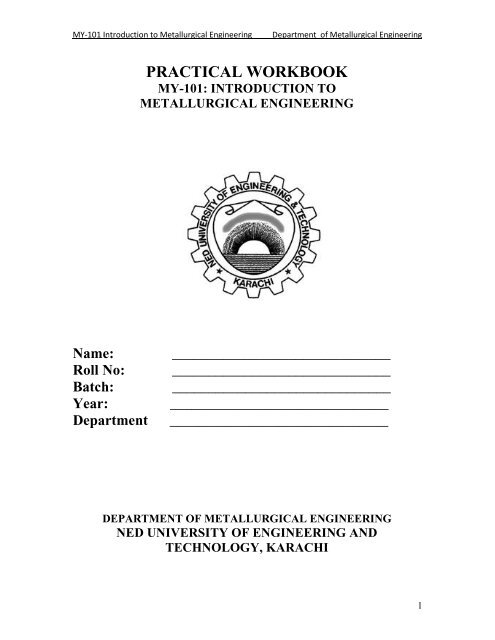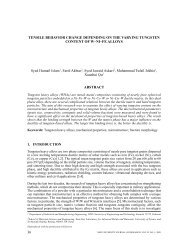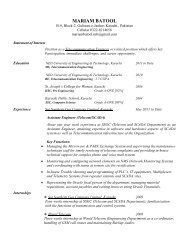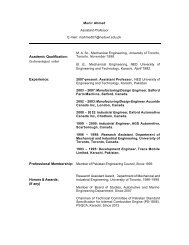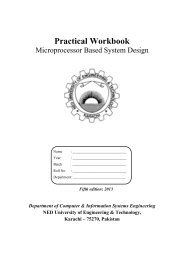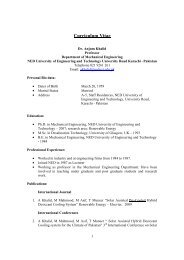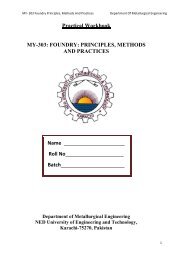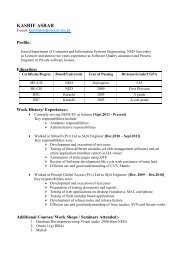MY-101 - NED University
MY-101 - NED University
MY-101 - NED University
Create successful ePaper yourself
Turn your PDF publications into a flip-book with our unique Google optimized e-Paper software.
<strong>MY</strong>-<strong>101</strong> Introduction to Metallurgical EngineeringDepartment of Metallurgical EngineeringPRACTICAL WORKBOOK<strong>MY</strong>-<strong>101</strong>: INTRODUCTION TOMETALLURGICAL ENGINEERINGName:Roll No:Batch:Year:Department______________________________________________________________________________________________________________________________________________________DEPARTMENT OF METALLURGICAL ENGINEERING<strong>NED</strong> UNIVERSITY OF ENGINEERING ANDTECHNOLOGY, KARACHI1
<strong>MY</strong>-<strong>101</strong> Introduction to Metallurgical EngineeringDepartment of Metallurgical EngineeringPRACTICAL WORKBOOK<strong>MY</strong>-<strong>101</strong>: INTRODUCTION TO METALLURGICALENGINEERINGPREPARED BY:AQEEL AHMED SHAH(Course Teacher)This is to certify that this practical book contains elevenpractical and _____ pages. All practical are prepared as percontents of course.Approved By:ChairmanDEPARTMENT OF METALLURGICAL ENGINEERING<strong>NED</strong> UNIVERSITY OF ENGINEERING AND TECHNOLOGY,KARACHI-75270, PAKISTAN2
<strong>MY</strong>-<strong>101</strong> Introduction to Metallurgical EngineeringDepartment of Metallurgical EngineeringCERTIFICATEIt is Certified that Mr. / Miss __________________________________________Student of class ______________________________ Batch_________________Bearing Roll No. _______________________________________ has completedhis/her course work in the subject of ____________________________________as prescribed and approved by Board of Review of Materials and MetallurgicalEngineering Department.His/Her performance is reflected by index/contents of his/her practical workbook.This overall performance of the student is Excellent/Very Good/Good(satisfactory)/Not Satisfactory________________Course Teacher3
<strong>MY</strong>-<strong>101</strong> Introduction to Metallurgical EngineeringDepartment of Metallurgical Engineering<strong>MY</strong>-<strong>101</strong>: INTRODUCTION TO METALLURGICALENGINEERINGList of PracticalS No. EXPERIMENTS Page No.01Name of the equipments and their purposes present in01Metallurgical Engineering laboratory.02 Identification of various engineering materials on the basis of density. 0303 Identification of iron ores on basis of their colour. 0704 Introduction to raw materials for pig iron production. 1005 Introduction to raw materials for steel production 1306 To carry out mounting of given specimen using Mounting Press machine. 1507 To study the working of Brinell hardness tester. 1808To study the working of Rockwell hardness tester.2209 To study the working of Micro Vickers Hardness Tester. 2510 To study the working of Vickers hardness tester. 2911 To study the operation of Metallurgical Microscope. 334
<strong>MY</strong>-<strong>101</strong> Introduction to Metallurgical EngineeringDepartment of Metallurgical EngineeringEXPERIMENT No. 01ObjectName of the equipments and their purposes in Metallurgical Engineering laboratory.TheoryMetallurgy is a study of Material sciences that studies the physical and chemicalbehaviour of metallic elements, their inter-metallic compounds, and their compounds,which are called alloys. It is also the technology of metals: the way in which science isapplied to their practical use. Metallurgy is commonly used in the craft of metalworking.In simpler words the study of behavior of metals and their compounds is known asmetallurgy.ProcedureName all the equipments present in the laboratory and write down purposes in the tablegiven below:ObservationEQUIPMENTPURPOSE5
<strong>MY</strong>-<strong>101</strong> Introduction to Metallurgical EngineeringDepartment of Metallurgical EngineeringQuestions1. Define metallurgy?______________________________________________________________________________________________________________________________2. How many types of optical microscope are present in laboratory?______________________________________________________________________________________________________________________________3. Responsibilities of a Metallurgical Engineer in the industry?________________________________________________________________________________________________________________________________________________________________________6
<strong>MY</strong>-<strong>101</strong> Introduction to Metallurgical EngineeringDepartment of Metallurgical EngineeringEXPERIMENT No. 02ObjectIdentification of various engineering materials on the basis of densityApparatusWeight balance, Vernier Caliper, Assorted SpecimenTheoryThe density of a material is defined as the mass per unit volume of the materialDensity can be expressed as follows:MassDensity =VolumeIts unit is grams per centimeters cube (g/cm 3 ). Metals, as a category, have higher densitythan plastic however, some metals are denser than others. Therefore, materials can becategorized on the basis of density.ProcedureFirst we take the mass of specimen by using weight balance. Measure the dimension ofthe specimen by using vernier caliper. Using the dimension, determine the volume of thespecimen by using the formulasVolume (cylinder) = π r 2 hVolume (rectangular) =Length * Width * HeightVolume (cone) = 1/3 π r 2 * heightVolume (sphere) = 4/3 π r1. Compare the observed density of each specimen with standard density.Table: 01DENSITY OF MATERIALSMATERIAL DENSITY (gm/cm 3 )Aluminum 2.7Copper 8.8Steel 7.85Polymers (Elastomers) 0.98Ceramics (Concrete) 2.4Composite Material0.46-0.50(Wood)7
<strong>MY</strong>-<strong>101</strong> Introduction to Metallurgical EngineeringDepartment of Metallurgical EngineeringTable:02STANDARD DENSITY FOR VARIOUS ENGINEERINGMATERIALS AT 20 0 CNo. Materials (gm/cm 3 )01. Aluminum Alloys 2.6 to 2.902 Copper alloys 7.5 to 9.o03 Lead alloys 8.9 to 11.304 Magnesium alloys 1.905 Nickel alloys 7.8 to 9.206 Titanium alloys 4.3 to 5.107 Zinc alloys 5.2 to 7.208 Carbon & low alloy Steels 7.809 High alloy Steels 7.8 to 8.110 Engineering Ceramics 2.2 to 3.911 Glasses 2 to 312 Thermoplastics 0.9 to 1.613 Polymer Foams 0.04 to 0.714 Engineering Composites 1.4 to 215 Concrete 2.4 to 2.516 Wood 0.4 to 1.817 Polyester (Thermoset) 1.04 to 1.462. Now identify the materials on the basis of densityMaterials may also be identified by appearance to some extent when in pure formTable: 03COLOUR IDENTIFICATIONMATERIALS COLOURAluminum WhiteCopper ReddishIron GreyZinc BluishTin Silvery8
<strong>MY</strong>-<strong>101</strong> Introduction to Metallurgical EngineeringDepartment of Metallurgical EngineeringCalculationVolume (specimen one) = _____________________= _____________________= _____________________Volume (specimen two) = _____________________= _____________________= _____________________Volume (specimen three) = _____________________= _____________________= _____________________Density of specimen one = _____________________= _____________________Density of specimen two = _____________________= _____________________Density of specimen three = _____________________= _____________________9
<strong>MY</strong>-<strong>101</strong> Introduction to Metallurgical EngineeringDepartment of Metallurgical EngineeringObservationNo. Specimen Mass Volume Density123ResultSpecimen one has identified as __________QuestionsSpecimen two has identified as __________Specimen three has identified as __________1. The density of a material is defined as the ______________of the material.2. The theoretical density of a metal can also be calculated using the properties ofthe__________________3. The unit of density in S.I system _____________, C.G.S system __________, F.P.Ssystem ______________.4. The density of Aluminum is_____________5. The density of Copper is________________6. The density of Stainless Steel is__________10
<strong>MY</strong>-<strong>101</strong> Introduction to Metallurgical EngineeringDepartment of Metallurgical EngineeringEXPERIMENT No. 03ObjectIdentification of iron ores on the basis of colour.ApparatusIron oresTheoryIRONIron is a metallic element with atomic number 26 and atomic weight 56. it is symbol is Fewhich comes from a Latin word “ferrum”. When its is pure it has a dark slivery greycolour. It is a very reactive element and oxidizes (rusts) very easily.Iron constitutes about 4.6% of earths crust and hence it is one of the most widelydistributed an abundant element in the nature.The naturally occurring materials containing iron are known as minerals of iron. Theminerals deposits from which iron is extracted are known as iron ores.CLASSIFICATION OF IRON ORESThe ores of iron are classed according to the iron mineral which is predominant. They arein the order of theoretical percentage of iron present in the mineral.MAGNETITES (Black Ores) Fe 3 O 4These iron ores contain 40% to 70% of iron. They are very hard and strongly magnetic.Magnetites also occur in a mixture with silica ( 35-37 iron and upto 60%silica) and arethen known as “ferruginous quartzites”. Ferruginous quartzites call for special methods ofdressing perpartion prior to smelting. The colour of magnetite is dark gray to black and aspecifc gravity 5.16 to 5.18. the magnetic property is important for it primary explorationby magnetic method and makes possible the megnetic separation of magnetite fromgangue materials to produce a high quality concentrate. Magnetite occurs in igneous,metamorphic and sedimentary rocks.HEMATITES (Red Ores) Fe 2 O 3These iron ores contain 45% to 65% of iron. Hematite are easily reduceable to metallicform and iron from. It can be produced at a lower cost. It usually contains littlephosphorous and sulphur. Usually, hydrated hematites contains 25% to 50% of iron. Thecolour of hematite ore are from steel gray to dull or bright red. The specific gravity is5.26. it’s common varieties are termed crystalline; specular, martite, earthy, maghemite,and compact.LIMONITES (Brown Ores) Fe 2 O 3 .H 2 OThese iron ores contain57.14% of iron with a 25.3% of water combination. Limonite’sare porous minerals. Limonites is the name commonly given to hydrous iron oxides that11
<strong>MY</strong>-<strong>101</strong> Introduction to Metallurgical EngineeringDepartment of Metallurgical Engineeringis a mixture of the cyoethite Hfe O 2 (Hydrous iron oxide) or lepidocrocite FeOCOH. Ithas a specific gravity in the range of 3.6 – 4.0, is commonly yellow or brown to nearlyblack in colour and is compact in early occurrence. It is a secondary mineral, formedcommonly by weathering and occurs in association with other iron oxides and insedimentary rocksSIDERITE (White Ores) FeCO 3It has a chemical compound of FeCO 3 (Iron Carbonate). The ore contains 48.20% of iron,37.99% of CO 2 , and 13.81% oxygen. The specific gravity is 3.83 and it’s colour variesfrom white to greenish gray and brown. It’s commonly contained variable amount of Ca,Mg, Cr, Mn. Sidrite varries from dense, fine grained and compact to crystalline. That oreare sometimes termed as spatrie iron ore or black band ore.LIMENITE (FeTiO 3 )It has a chemical compound of FeTiO 3 (iron titanium oxide) contains to 36.82% iron,31.7% titanium and 31.63% oxygen. This is commonly considered as iron titanate. It isoften associated in small amount with magnetiteProcedureIdentify the name and the properties of the sample of given iron ore by looking at itscolour and physical properties.Colour______________________________________________________PhysicalProperties_______________________________________________________________________________________________________________________________________________________________________________________________________________________Conclusion:12
<strong>MY</strong>-<strong>101</strong> Introduction to Metallurgical EngineeringDepartment of Metallurgical EngineeringQuestions:1. Define iron?____________________________________________________________________________________________________________________________________________________________________________________________________________2. Complete the table below with the name, colour and chemical composition of all theiron ores.Name of Iron Ore Colour Chemical composition (%)3. What is the percentage of iron metal in earth’s crust (a) 4.6% (b) 3.55% (c) 40% (d)None of above.13
<strong>MY</strong>-<strong>101</strong> Introduction to Metallurgical EngineeringDepartment of Metallurgical EngineeringEXPERIMENT No.04ObjectIntroduction to raw materials for pig iron productionApparatusIron ore, coke, flux (lime stone), and ferroalloysTheoryThese are the raw materials used for the production of pig iron. Coke (fuel), a solidcarbonaceous residue derived from destructive distillation of coal.Iron ores are rocks and minerals from which metallic iron can be economicallyextracted. The ores are usually rich in iron oxides and vary in colour from dark grey,bright yellow, deep purple, to rusty red. The iron itself is usually found in the form ofmagnetite (Fe 3 O 4 ), hematite (Fe 2 O 3 ), goethite, limonite or siderite. Hematite is alsoknown as "natural ore"(Fig.1). The name refers to the early years of mining, when certainhematite ores contained 66% iron and could be fed directly into iron making blastfurnaces. Iron ore is the raw material used to make pig iron, which is one of the main rawmaterials to make steel. 98% of the mined iron ore is used to make steel.A related use of the term flux is to designate the material added to the contents of asmelting furnace or a cupola for the purpose of purging the metal of impurities, and ofrendering the slag more liquid. The flux most commonly used in iron and steel furnaces islimestone, which is charged in the proper proportions with the iron and fuel. The slag is aliquid mixture of ash, flux, and other impuritiesWhereas Ferroalloy refers to various alloys of iron with a high proportion of one or moreother element, manganese or silicon for example. It is used in the production of steels andalloys as a raw material(Fig.1) IRON ORE14
<strong>MY</strong>-<strong>101</strong> Introduction to Metallurgical EngineeringDepartment of Metallurgical EngineeringProcedureExplain yourself about this practical.______________________________________________________________________________________________________________________________________________________________________________________________________________________________________________________________________________________________________________________________________________________________________________________________________________________________________________________________________________________________________________________________________________________________________________________________________________________________________________________________________________________________________________________________________________________________________________________________________________________________________________________________________________________________________________________________________________________15
<strong>MY</strong>-<strong>101</strong> Introduction to Metallurgical EngineeringDepartment of Metallurgical EngineeringEXPERIMENT No.05ObjectIntroduction to raw materials for steel productionApparatusSteel Scrap, coke breeze (powder form) and/or Carbon powder (98% pure), flux (lime,dolomite, CaF 2 (fluorspar)), and ferroalloysTheoryThese are the raw materials used for the production of steels. Coke (fuel), a solidcarbonaceous residue derived from destructive distillation of coal.Scrap is a term used to describe recyclable materials left over from every manner ofproduct consumption (such as parts of vehicles, building supplies, and surplus materials).Often confused with waste, scrap in fact has monetary value and is one of the UnitedStates’ largest exports. Whereas ferroalloys are the raw materials (impure/raw alloys ofFe, Cr, Mn, C) containing iron (Fe) and other elements like Mn, Cr, C, etcA related use of the term flux is to designate the material added to the contents of asmelting furnace or a cupola for the purpose of purging the metal of impurities, and ofrendering the slag more liquid. The flux most commonly used in iron and steel furnaces islimestone, which is charged in the proper proportions with the iron and fuel. The slag is aliquid mixture of ash, flux, and other impurities.Whereas Ferroalloy refers to various alloys of iron with a high proportion of one or moreother element, manganese or silicon for example. It is used in the production of steels andalloys as a raw material.ProcedureExplain yourself about this practical.________________________________________________________________________________________________________________________________________________________________________________________________________________________________________________________________________________________________________________________________________________________________________________________________________________________________________________17
<strong>MY</strong>-<strong>101</strong> Introduction to Metallurgical EngineeringDepartment of Metallurgical EngineeringEXPERIMENT No. 06ObjectTo carry out mounting of given specimen using Mounting Press Machine.ApparatusMounting press specimen, bakelite, funnel, measuring spoon, and mould release wax.TheoryThe mounting press machine is an Automatic Mounting Press shown in Fig. 1. Theprimary purpose of mounting is for convenience is handling specimens of difficult shapesor sizes during the subsequent steps of preparation and examination. A secondary purposeis to protect and preserve extreme edges of surfaces defects during preparation. Thicknessof the mount should be sufficient to enable the operator to hold the mount firmly duringgrinding and polishing thereby to prevent a rocking motion and to maintain a flat surface.Circular mounts are commonly 1 to 2 in. in diameter and are the most easily handled.Different types of mounting methods are available e.g. clamp mounting, compressionmounting, cold mounting etc. we use compression mounting method in experiment usingautomatic hydraulic mounting press.Compression mounting, the most common mounting method involves molding aroundthe specimen by heat pressure. Molding materials used are bakelite, aniline formaldehydecompound resins, and acrylic, Lucite resins etc. bakelite and aniline formaldehydecompound resins are thermosetting, and acrylic and Lucite resins are thermoplastic. Formaking transparent mold we may use Lucite. Both thermosetting and thermoplasticmaterials require head and pressure during the molding cycle, but after curing, mountsmade of thermosetting materials may be ejected from the mold at maximum temperature.Thermoplastic materials remain molten at the molding temperature and must cold underpressure before ejection. Mounting presses quipped with molding tools and a heater isnecessary compression mounting. The cylinder is nearly filled with molding material inpowder form, and the plunger is inserted into open end of the cylinder. A cylinder heateris placed around the mold assembly, which has been exerted and maintained on theplunger to compress the molding material until it and the mold assembly has been heatedto the proper temperature, the finished mount may be ejected from the mould by forcingthe plunger entirely through the mould cylinder.19
<strong>MY</strong>-<strong>101</strong> Introduction to Metallurgical EngineeringDepartment of Metallurgical Engineering(Fig.1) MOUNTING PRESS MACHINEProcedure1. The inner ram pressure I supplied by hydraulic pressure. To activate the ram,the “Ram Up” and “Ram Down” buttons on the control panel are used.2. Raise the ram until the top below the edge of mold assembly.3. Apply mold release inside the mold chamber. When using either spray ofliquid silicone mold release.4. Raise the ram from flush with the top of the assembly.5. Place the specimen onto the lower ram and lower is using the ram downbutton until fully down.6. Apply enough mounting material to cover the mount, as well extra material ontop, so the top ram does not make contact with the part.7. If using the duple Xing spacer to produce two mounts in one cycle, place thespacer on top of the mounting material covering the first sample.8. Swing the top ram/die over the mold chamber. The ram is spring loaded forease of removal when unloading the chamber. Push down on the bayonethandles and turns it clock wise to lock the lid until stops hard against thebayonet.9. Press the button “RUN” to the menu screen, select the menu and press “Run”again to begin the cycle.20
<strong>MY</strong>-<strong>101</strong> Introduction to Metallurgical EngineeringDepartment of Metallurgical Engineering10. This cycle will automatically raise the ram into the top and begin heating themold.11. Do not touch the molds while it I heating or cooling, as it may cause a painfulburn.12. During the cycle, an illuminated LED on the display panel will indicateoperation of a cycle (Cycle On), and whichever cycle is operating: Pre-Heat,Heat or Cool.13. When the cycle is complete, an alarm will sound as a series beeps. The moldwill lower automatically enough to loosen and rotate bayonet open. Loosenthe bayonet by turning the top handle, counterclockwise, until it is unlocked. Itmight be necessary to lower the ram a little more to loosen the bayonet, whichcan be done by pressing the “Ram Down” button.14. List the top ram up and swing it away around to the rear where it may rest onthe heat sink until it is ready to be used again. The sample may be removed atthis time.ResultSmall specimen is successfully mounted in thermosetting plastic and bakelite.Questions1. The purpose of mounting is to _____________________________________.2. Different types of mounting methods are _____________________________.3. Mounting press used in the experiment is _____________________________.4. Mounting material used in the experiment is __________________________.5. The mounting temperature for thermo setting plastic is __________________.6. For making transparent mount we use ______________ as mounting material.7. Diameter of the mount made in the experiment is ______________________.8. Mounting force is used in the experiment is ___________________________.21
<strong>MY</strong>-<strong>101</strong> Introduction to Metallurgical EngineeringDepartment of Metallurgical EngineeringEXPERIMENT No. 07ObjectTo study the working of Brinell hardness testerApparatusBrinell hardness testerTheoryThe figure 1. Below shows the description of brinell hardness testerThe principle of hardness tester:Hardness is the resistance to penetration, scratching. In the Brinell hardness method, theindenter size and the load to be applied are determined from the scales provided for thetype of material to be tested.The hardness is calculated by the following formula.Where,BHN =Pπ D/2 (D - √D²- d²)P= Major LoadD= Diameter of the balld= Indentation diameterAn indenter (An hard metal ball with diameter D) is forced into the surface of a test pieceand the diameter of the indentation d left in the surface after removal of the force F ismeasured.The brinell hardness is proportional to the quotient obtained by dividing the test force bythe curved surface area of the indentation. The indentation is assumed to be sphericalwith a radius corresponding to half of the diameter of the ball.The brinell number which normally raises from HB50 to HB750 for metals, will increaseas the sample gets harder.22
<strong>MY</strong>-<strong>101</strong> Introduction to Metallurgical EngineeringDepartment of Metallurgical Engineering(Fig. 1) BRINELL HARDNESS TESTER23
<strong>MY</strong>-<strong>101</strong> Introduction to Metallurgical EngineeringDepartment of Metallurgical Engineering1. LCD 2. Keyboard3. ProtectiveNose4. Indenter (Insideprotective nose)Tester Parts5. Anvil 6. Screw Pindle7. Emergencystop8. Printer9. RS232 10. Cable interface11. Main switch 12. Fuse holderProcedureExplain yourself about this practical.__________________________________________________________________________________________________________________________________________________________________________________________________________________________________________________________________________________________________________________________________________________________________________________________________________________________________________________________________________________________________________________________________________________________________________________________________________________Question1. Unit for measuring Brinell’s hardness isa. HRBb. Hardness numberc. Grams /mmd. None of the above24
<strong>MY</strong>-<strong>101</strong> Introduction to Metallurgical EngineeringDepartment of Metallurgical Engineering2. Diamond indenter is used ina. Brinell is Hardness testb. Rockwell Hardness testc. Both of the above3. A Brinell’s Hardness test was done on the following materials and results tabulatedAs followsa. Materials A, HB=200b. Materials B, HB=100c. Materials C, HB=50Which materials is the hardest?Answer ____________4. A ball of 5mm diameter is used as indenter in a brinell’s Test on 3 different materialsall subjected to the same load. The size of the indentation diameter was found to bea. MATERIAL A, d= 1.5mmb. MATERIAL B, d=1.3mmc. MATERIAL C, d=1.1mmWhich material is the hardest?Answer25
<strong>MY</strong>-<strong>101</strong> Introduction to Metallurgical EngineeringDepartment of Metallurgical EngineeringEXPERIMENT No. 08ObjectTo Study the working of Rockwell hardness testerApparatusRockwell hardness testerTheoryThe Rockwell Hardness tester shown in fig.1 is uses a machine to apply a specific loadand then measure the depth of the resulting impression. The indenter may either be a steelball of some specified diameter or a spherical diamond-tipped cone of 120° angle and 0.2mm tip radius, called a brale. A minor load of 10 kg is first applied, which causes a smallinitial penetration to seat the indenter and remove the effects of any surface irregularities.Then, the dial is set to zero and the major load is applied. Upon removal of the majorload, the depth reading is taken while the minor load is still on. The hardness numbermay then be read directly from the scale. The indenter and the test load used determinethe hardness scale that is used (A, B, C, etc).For soft materials such as copper alloys, soft steel, and aluminum alloys a 1/16" diametersteel ball is used with a 100-kilogram load and the hardness is read on the "B" scale. Intesting harder materials, hard cast iron and many steel alloys, a 120 degrees diamondcone is used with up to a 150 kilogram load and the hardness is read on the "C" scale.There are several Rockwell scales other than the "B" & "C" scales, (which are called thecommon scales). A properly reported Rockwell value will have the hardness numberfollowed by "HR" (Hardness Rockwell) and the scale letter. For example, 50 HRBindicates that the material has a hardness reading of 50 on the B scale.The Basic Principle of Rockwell Hardness TesterAll the beginning of the test, place the indenter of tester on the specimen surface, appliesa preliminary load and establishes a reference point that a displacement transducermeasures. Because the indenter penetrates into the specimen surface by means ofpreliminary load, surface roughness or irregularities do not affect the test. Next, the testerapplies the main load. The larger force penetrates deeper into the specimen. Then, thetester removes the main load, meanwhile, still applying the preliminary load. At thispoint, the tester measures the depth of the indent relative to the established referencepoint.26
<strong>MY</strong>-<strong>101</strong> Introduction to Metallurgical EngineeringDepartment of Metallurgical Engineering(2) Rockwell hardness test formulasIn which:n0 = indenter depth from preliminary loadn1 = indenter depth from applies total test load F, then removes main load F1, butremains preliminary test load F0.(Fig.1) ROCKWELL HARDNESS TESTER27
<strong>MY</strong>-<strong>101</strong> Introduction to Metallurgical EngineeringDepartment of Metallurgical EngineeringTester PartsProcedureExplain yourself about this practical.__________________________________________________________________________________________________________________________________________________________________________________________________________________________________________________________________________________________________________________________________________________________________________________________________________________________________________________________________________________________________________________________________________________________________________________________________________________28
<strong>MY</strong>-<strong>101</strong> Introduction to Metallurgical EngineeringDepartment of Metallurgical EngineeringEXPERIMENT No. 09ObjectTo study the working of Micro Vicker Hardness TesterApparatusMicro Vickers Hardness TesterTheoryThe digital Vickers micro-hardness tester is shown is fig.1 is especially designed to testthe structure of tiny or minute metal parts, this plates, metals foil, high quality cord, thinhardening layers and electroplated layers. In addition, it can also find wide applications intesting non-metallic materials such as glass, jewelry, ceramics etc, which can hardly bemeasured with Rockwell or other hardness testers using relatively large test load. Inparticulars, it could manage to measure the internal hardness of induction hardeningmaterial or carburized material by following the metal structure.The test is performed in two steps. First, the diamond indenter is driven into the surfaceof the tester material by applying a known load force. Second, the user measures thediagonals(s) length of the resulting indentation and input the measured length ofdiagonals(s) to the integrated calculator, by which hardness value could be acquiredeither in Vickers scale (HV).Principle of OperationThe tester will exert test forces on a specimen by using weights and a lever mechanism(force amplification).After selecting a test force, the user should press . The motor drives the leverto release the weights corresponding to the selected force, then the released weights pressindenter down to make an indentation on the specimen in a specified period which ispreset in the software system by the user.After the indenter has left the specimen to travel back to the starting position, the userturns the turret to 40* objective to measure to diagonals(s). The measuring microscopehas adjustable filer lines. The user can adjust the lines to just touch the tips of theindentation. Now the user can press the “Reading Enter Key” to input the measured resultinto the integrated calculator.The calculator then computer and displays the Vickers hardness value by using formulaspresented in this chapter.29
<strong>MY</strong>-<strong>101</strong> Introduction to Metallurgical EngineeringDepartment of Metallurgical EngineeringPrinciple of Test MethodThe top of the Vickers indenter is in shape of pyramid with a face angle of 136. Thedepth of indentation it makes is about 1/7 of its diagonal length.The Vickers indenter can penetrate into the specimen about twice as deep as that byknoop indenter. Therefore, the Vickers tester is less sensitive to specimen surface as theknoop tester. Because, the indentation is finish, Vickers test can be used on materials thatcannot be tester by knoop indenter. However, because of the deeper indentation, theVickers test is not suitable for testing very thin metal foils and thin (coating) layers. Inthese cases knoop test could perform better. Under condition of equal loads, the Vickersindenter (because of its shorter length) is more sensitive to errors in measuring the indent.Vickers test is generally divided into two types:Micro = 10 to 2000 gfMacro = above 2000The Vickers hardness value could be calculated from the following formula:Where:HV- Vickers Hardness valueF- Test Force, NS- Surface area of indentation, mm 2D- Mean diagonal length of indentation, mmθ- Face angle of indenter = 136°0Sometimes the load unit kgf is used. If kgf is used, the equation for Vickers hardnessvalue can be expressed as following:30
<strong>MY</strong>-<strong>101</strong> Introduction to Metallurgical EngineeringDepartment of Metallurgical Engineering(Fig.1) MICRO VICKER HARDNESS TESTERTester Parts31
<strong>MY</strong>-<strong>101</strong> Introduction to Metallurgical EngineeringDepartment of Metallurgical EngineeringProcedureExplain yourself about this practical.______________________________________________________________________________________________________________________________________________________________________________________________________________________________________________________________________________________________________________________________________________________________________________________________________________________________________________________________________________________________________________________________________________________________________________________________________________________________________________________________________________________________________________________________________________________________________________________________________________________________________________________________________________________________________________________________________________________32
<strong>MY</strong>-<strong>101</strong> Introduction to Metallurgical EngineeringDepartment of Metallurgical EngineeringEXPERIMENT NO. 10ObjectTo study the working of Vickers hardness testerApparatusVickers hardness testerTheoryThe Vickers hardness tester as shown in fig.1. The method consists of indenting the testmaterial with a diamond indenter, in the form of a right pyramid with a square base andan angle of 136 degrees between opposite faces subjected to a load of 1 to 100 kgf. Thefull load is normally applied for 10 to 15 seconds. The two diagonals of the indentationleft in the surface of the material after removal of the load are measured using amicroscope and their average calculated. The area of the sloping surface of theindentation is calculated. The Vickers hardness is the quotient obtained by dividing thekgf load by the square mm area of Indentation33
<strong>MY</strong>-<strong>101</strong> Introduction to Metallurgical EngineeringDepartment of Metallurgical EngineeringWhere,F= Load in kgfd = Arithmetic mean of the two diagonals, d1 and d2 in mmHV = Vickers hardnessWhen the mean diagonal of the indentation has been determined the Vickers hardnessmay be calculated from the formula, but is more convenient to use conversion tables. TheVickers hardness should be reported like 800 HV/10, which means a Vickers hardness of800, was obtained using a 10 kgf force. Several different loading settings give practicallyidentical hardness numbers on uniform material, which is much better than the arbitrarychanging of scale with the other hardness testing methods. The advantages of the Vickershardness test are that extremely accurate readings can be taken, and just one type ofindenter is used for all types of metals and surface treatments. Although thoroughlyadaptable and very precise for testing the softest and hardest of materials, under varyingloads, the Vickers machine is a floor standing unit that is more expensive than the Brinellor Rockwell machines.VICKERS HARDNESS TEST (Fig.1)34
<strong>MY</strong>-<strong>101</strong> Introduction to Metallurgical EngineeringDepartment of Metallurgical EngineeringTester Parts35
<strong>MY</strong>-<strong>101</strong> Introduction to Metallurgical EngineeringDepartment of Metallurgical EngineeringProcedureExplain yourself about this practical.__________________________________________________________________________________________________________________________________________________________________________________________________________________________________________________________________________________________________________________________________________________________________________________________________________________________________________________________________________________________________________________________________________________________________________________________________________________________________________________________________________________________________________________________________________________________________________________________________________________________________________________________________________________________________________________________________________________________________________________________________________________________________________________________________36
<strong>MY</strong>-<strong>101</strong> Introduction to Metallurgical EngineeringDepartment of Metallurgical EngineeringObjectEXPERIMENT No. 11To study the operation of Metallurgical MicroscopeApparatusMetallurgical MicroscopeTheoryMetallurgical microscopes as shown in fig.1 are used for identification and analysis of thestructures of different metals and alloys. They are important instruments for the researchof metallurgy. They can be used for quality research of foundry, smelt and heat treatment,for testing of raw and processed materials or for analysis of heat treatment materials.They are ideal instrument for scientific research, teaching, factories and so on.Principle of Metallurgical MicroscopeIn Metallurgical Microscope, a horizontal beam of light from some light source isreflected, by means of a plane-glass reflector, downward through the microscopeobjective onto the surface of the specimen. Some of this incident light reflectedfrom the specimen surface will be magnified in passing through the lower lenssystem, the objective, and will continue upward through the plane glass reflectorand be magnified again by the upper lens system, the eyepiece. The initialmagnifying power of the objective and the eyepiece is usually engraved on the lensmount. When a particular combination of objective and eyepiece is used at theproper tube length, the total magnification is equal to the product of themagnifications of the objective and the eyepiece.The maximum magnification obtained with the optical microscope is about 2OOOxPrinciple LimitationThe principal limitation is the wavelength of visible light, which limits theresolution of fine detail in the metallographic specimen. The magnification may beextended somewhat by the use of shorter-wavelength radiation, such as ultravioletradiation, but the sample preparation technique is more involved.37
<strong>MY</strong>-<strong>101</strong> Introduction to Metallurgical EngineeringDepartment of Metallurgical EngineeringMicroscope Parts(Fig.1) METALLURGICAL MICROSCOPE38
<strong>MY</strong>-<strong>101</strong> Introduction to Metallurgical EngineeringDepartment of Metallurgical Engineering1. Eye Piece 10. Lamp Box2. Binoculars 11. Lamp Holder Lock Screw3. Stretchy Clip 12. Lamp Adjustment Pole4. Mechanical 13. Field Diaphragm Adjustment Screw5. Objective 14. Cross Movement Knob6. Field Diaphragm 15. Lengthways Movement KnobsStage Adjustment Pole16. Fine Focusing Knob7. Aperture Diaphragm Adjustment Pole 17. Coarse Focusing Knob8. Filter 18. Limit Knob9. Condenser Adjustment Pole 19. Tube Holding Screw20. Electrical Outlet 21. Power SupplyQuestion1. In Metallurgical Microscope a horizontal beam of Passesthrough a plane glass reflector.2. The total magnification is equal to the product of the magnification of the objectiveand the _______________.3. The maximum magnification obtained with the Metallurgical Microscope is about__________________.4. A Metallurgical Microscope helps determine ___________and ___________.5. In Metallurgical Microscope illumination beam is ________________.39


